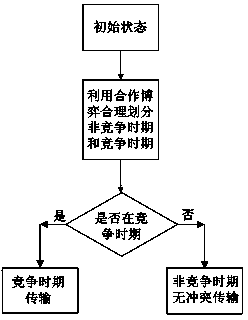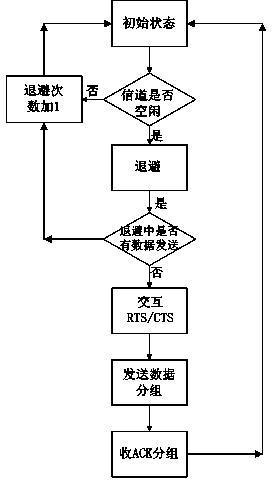Multi-service cooperation multiple access method based on cooperative game in distributed self-organized network
A technology of cooperative game and access method, applied in access restriction, network topology, electrical components, etc., to achieve the effect of avoiding fairness problems and selfish node problems, high normalized throughput performance, and avoiding selfish node problems
- Summary
- Abstract
- Description
- Claims
- Application Information
AI Technical Summary
Problems solved by technology
Method used
Image
Examples
Embodiment Construction
[0045] Step 1: Use the cooperative game to divide the non-competitive period and the competitive period
[0046] Using the bargaining game in the cooperative game, nodes with different priority service types adaptively determine an optimal transmission scheme. The bargaining problem is usually used to model two things with conflicting interests to work together to negotiate a suitable compromise. In this patent, it is assumed that each node has two priority types: High Priority (HP) and Low Priority (LP), but can only have one priority type in the same sending period. HP nodes and LP nodes are two individuals with conflicting interests. They both want to occupy channel resources to maximize their performance, especially LP nodes, which are seriously unfair under the traditional mechanism, and therefore may become selfish nodes. In order to solve the problems of fairness and selfish nodes in the traditional multi-service multiple access method, this patent uses a cooperative g...
PUM
 Login to View More
Login to View More Abstract
Description
Claims
Application Information
 Login to View More
Login to View More - R&D
- Intellectual Property
- Life Sciences
- Materials
- Tech Scout
- Unparalleled Data Quality
- Higher Quality Content
- 60% Fewer Hallucinations
Browse by: Latest US Patents, China's latest patents, Technical Efficacy Thesaurus, Application Domain, Technology Topic, Popular Technical Reports.
© 2025 PatSnap. All rights reserved.Legal|Privacy policy|Modern Slavery Act Transparency Statement|Sitemap|About US| Contact US: help@patsnap.com



